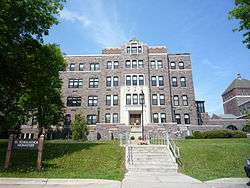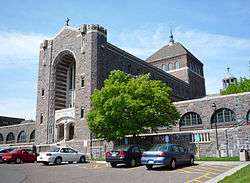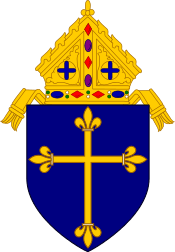College of St. Scholastica
 | |
| Motto | Omnes Semitae Eius Pacificae |
|---|---|
Motto in English | "All her paths are peace" |
| Type | Private |
| Established | 1912 |
Religious affiliation | Roman Catholic (Benedictine) |
| Endowment | $67.5 million (February 2015)[1] |
| President | Dr. Colette McCarrick Geary |
| Students | 4,237 (fall 2014) |
| Undergraduates | 2,859 (fall 2014) |
| Postgraduates | 1,378 (fall 2014) |
| Address |
1200 Kenwood Ave Duluth, Minnesota 55811, Duluth, Minnesota, USA 46°48′58″N 92°06′22″W / 46.81612°N 92.10624°WCoordinates: 46°48′58″N 92°06′22″W / 46.81612°N 92.10624°W |
| Campus | Suburban: 186 acres (75 ha) |
| Colors | Royal Blue and Gold |
| Athletics | NCAA Division III – UMAC, NCHA, CCSA |
| Sports |
20 varsity teams (10 men's & 10 women's) |
| Nickname | Saints |
| Mascot | Storm the Saint Bernard |
| Affiliations |
ACCU[2] NAICU CIC |
| Website |
css |
|
| |


The College of Saint Scholastica (CSS) is a private college with its main campus in Duluth, Minnesota, United States. Today St. Scholastica educates more than 4,000 students annually and has graduated more than 24,000 alumni.
In 2016, U.S. News & World Report ranks College of St. Scholastica at #33 of regional universities in the Midwest.[3]
History
The College of St. Scholastica owes its existence to the combining of two forces: Benedictine missionaries and the settlement of Duluth. In 1892,[4] Mother Scholastica Kerst and 28 Sisters arrived from St. Joseph, Minnesota, to spearhead the establishment of a Benedictine mother-house and an academy in Duluth.
The school and convent were located at Munger Terrace before growth required a move to a new facility at Third Avenue East and Third Street. Named Sacred Heart Institute, the high school continued to grow rapidly. Duluth’s rapid expansion led to a third move in 1909 to its present location.
Mother Scholastica’s vision for the College can be summed up in this quote attributed to her: “My dream is that someday there will rise upon these grounds fine buildings like the great Benedictine abbeys. They will be built of stone: within their walls higher education will flourish.”[5]
The school expanded its course offerings in 1912 to include a junior college and changed its name to The College of St. Scholastica. The College started with only six students, and 52 courses were offered in eight departments in its first year.[6] Academic leadership and research were stressed early as an integral part of the College's commitment to Benedictine values. In 1924, the College became a four-year liberal arts institute with an enrollment of 68. The school's first baccalaureate degrees were granted in 1926. In 1969 it became a fully coeducational institution.
Symbols
The shield of the College shows a lily, blooming with three flowers symbolizing the three Persons of the Blessed Trinity.[7] The base of the lily is enclosed by a crescent, the heraldic symbol of the Virgin Mary, and the purity of Christian teaching.[8] Symbolizing the college, a book occupies the center of the field, bearing the motto of St. Scholastica. It is adapted from the second part of the Book of Proverbs line “Her ways are ways of beauty, and all her paths are peace,” and reads in Latin, “Omnes semitae eius pacificae.”[9]
Campuses
In addition to the main campus in Duluth, St. Scholastica has sites in Brainerd, St. Cloud, Rochester, St. Paul, Phoenix, AZ, and a virtual campus.
The Duluth campus is home to most undergraduate students. The 186-acre campus is set on a hill overlooking Lake Superior. Campus buildings include: Tower Hall, the Science Center, Our Lady Queen of Peace Chapel, Burns Wellness Commons, the 500-seat Mitchell Auditorium, the College Library, the St. Scholastica Theatre, Somers Residence Hall, and nine apartment complexes. A new Health Science Center housing graduate health science programs will open for classes this September. The building is at 940 Woodland Ave. in the BlueStone development, about a mile from the main campus.
Library
The College Library provides over 350,000 print and electronic books, full-text journal databases, interlibrary loan services, laptops, wireless Internet access, group study rooms, and quiet study space. It is located on the upper floors of the Romanesque-styled Our Lady Queen of Peace Chapel building. Along with the Library, the College Archives preserves the written and visual history of the College, as well as housing special collections such as the papers of James Franklin Lewis.[10]
Tower Hall
Tower Hall is St. Scholastica’s castle-like central building. Its origins date to a picnic in around 1907, when the Diocese of Duluth’s Bishop James McGolrick commented that the top of the hill at the College’s current site was a perfect location for a building.[11] According to the historic records of Sister Agnes Somers, McGolrick and a group of students and Sisters climbed to the top of the hill and placed a pile of stones, symbolizing the cornerstone of what would eventually become Tower Hall.[12] The following year saw the groundbreaking and start of construction for Tower Hall. Its first unit was completed in 1909. That September, 75 students from the Institute of the Sacred Heart were relocated to what was then called Villa St. Scholastica. Tower Hall was completed in 1928, and had two towers, a north to south axis of 375 feet, turrets at each end, recessed fenestration, and Tudor towers flanking the façade.
Sharing the campus are St. Scholastica Monastery, home of the Benedictine Sisters; and the Benedictine Health Center and Westwood Assisted Living Facility, which provide experiences for many of the College's health science and behavioral arts and sciences students.
In September 2012, the College's Centennial year, St. Scholastica opened a 40,000 square-foot addition to its existing 125,000 square-foot Science Center. The addition includes 7 laboratories for chemistry and biochemistry, 6 faculty-undergraduate student research areas, 2 classrooms for pre-laboratory meetings and general class use, faculty offices, an atrium-style gathering area, a greenhouse, and state-of-the-art environmental and sustainable technologies throughout, including for storage of chemicals and treatment of hazardous waste.
Organization and administration
As a Benedictine institution, the College remains affiliated to the Order of Saint Benedict. Its endowment stands at more than $70 million.
Board of Trustees
Current members of the College's Board of Trustees are: Abbot Apter, Patricia Bower-Jernigan, Daniel (Dan) Clay, Ed Crawford, Sister Mary Susan Dewitt, O.S.B, Chris Dolan, Jessica Durbin, Sister Lois Eckes, O.S.B., Larry Goodwin, Ph.D., Beth Haenke Just, Mary Ives, Tricia (Trish) Johnson, Mathew (Mat) Johnson, Olivia Krejcarek, Sister Jean Maher, O.S.B., Melanie Mogg, Dr. Vincent Ohaju, Michael O'Keefe, Kelly Palmer, Paul Puerzer, Bob Schroeder, Doug Schur, Jacqulin (Jacquie) Sebastian, Dan Seeler, Sister Mary Catherine Shambour, O.S.B., Sister Sarah Smedman, O.S.B., Ph.D., David Sparby, Denise Starkey, Marcy Steinke, and Dr. Louise Town. St. Scholastica’s curriculum is divided between six schools: the School of Arts and Letters, School of Business and Technology, School of Education, School of Health Sciences, School of Nursing, School of Sciences.
College Presidents
Mother Agnes Somers 1924-1942, Mother Athanasius Braegeleman 1942–1954, Mother Martina Hughes 1954-1958, Sister Joselyn Baldeschweiler 1958-1960, Sister Ann Edward Scanlon 1960-1967, Sister Mary Richard Boo 1967-1971, The Rev. F.X. Shea 1971-1974, Sister Joan Braun 1974-1975, Bruce Stender 1975-1981, Daniel Pilon 1981-1998, Larry Goodwin 1998–present. Dr. Goodwin announced in 2015 that he would retire at the end of June 2016; Dr. Colette McCarrick Geary has been named the 12th president of the College and started her duties on July 1.
Academic profile
The College awards bachelor's, master's degrees, and doctoral degrees, and has a faculty to student ratio of 14:1.
Undergraduate majors include liberal arts and science programs as well as pre-professional programs.
Graduate degrees are offered in health professions, technology, business, and social work.
All first-year students take part in a program called Dignitas (Dignity). The program’s goals are that participants will accept and value the challenges and responsibilities involved in being a first-year college student, reflect on issues from various perspectives, and make connections with the larger community. A combination of course material, co-curricular activities, and common experiences is intended to prepare students for learning both during and after college.
Student life
Campus housing
St. Scholastica houses students living on campus in nine buildings. They are:
- Cedar Hall Apartments – Opened in 2003. 100 residents. Total square footage 875 sq ft (81.3 m2). / unit.
- Kerst Hall – Opened in 2005. 160 students . Total square footage 875 sq ft/unit.
- Pine, Maple, Willow and Birch Apartments – Nearly identical. Built in 1973, 1989, 1989, and 1990 respectively. 43 residents each. Total square footage 716 sq ft/unit.
- Scanlon Hall – Opened in 2005. 128 residents . Total square footage 875 sq ft/unit.
- Somers Hall – Built in 1964. Primarily first-year housing. Population 314 students. Building also houses the Greenview Dining Room, Somers Main Lounge, Office of Residential Life, Health Services, Campus Operator, and a penthouse lounge / study area. Dorms measure 9'3" x 17'4" (double room) and 6'5" x 17'4" (single-room).
- Somers Suites – Built in 1993. Connected to Somers Hall. Four floors. Suites have a square footage of 525 sq ft (48.8 m2). (2 bedroom) or 775 sq ft (72.0 m2). (3 bedroom).
Student Senate
St. Scholastica’s Student Senate is responsible for making decisions that affect the lives of the student body. The senate has 48 seats, which include 10 each from the freshman, sophomore, junior and senior classes; two graduate students, and two transfer or previously studying-abroad students. Senate officers include the president, executive vice president, financial vice president and administrative vice president. The Student Senate’s mission is to facilitate and advocate for the effective training and support of past, present and future student leaders.
On 26 August 2014, some students from the college went to BNU-HKBU United International College to be interns.[13]
Athletics
The College of St. Scholastica fields 20 athletic teams, including 10 women's (basketball, cross country, Nordic skiing, soccer, softball, indoor track & field, outdoor track & field, hockey, tennis and volleyball) and 10 men's teams (basketball, cross country, Nordic skiing, soccer, baseball, indoor track & field, outdoor track & field, hockey, football and tennis). The college's athletic teams are called the Saints. All of teams, except ice hockey and Nordic skiing, compete in the Upper Midwest Athletic Conference which is part of the NCAA's Division III.
Men's Soccer
The St. Scholastica Men's Soccer team compete in the Upper Midwest Athletic Conference (UMAC) led by Head Coach Barry Chastey. The Saints men's soccer team have been UMAC Regular Season Champions 11 times, including winning the UMAC tournament a total of 9 times. The Saints also made their first appearance at the NCAA National Soccer Tournament in the 2010 season as well as winning the UMAC regular season and the UMAC tournament. Their Home games are played at the Saints Field located on campus.
Baseball
The Saints have won 19 straight Upper Midwest Athletic Conference (UMAC) regular season and post-season titles from 1996 to 2015. The baseball team plays their home games in Wade Stadium, which is also the home of the Duluth Huskies of the Northwoods League.
Ice Hockey
.jpg)
The men's hockey team competes in NCAA Division III as part of the Northern Collegiate Hockey Association (NCHA). During the 2006-07 the Saints defeated the University of Wisconsin–Superior two games to one in the opening round of the NCHA Tournament and then defeated the University of Wisconsin–River Falls by the score of 2-1 in the NCHA Semifinals to advance to their first NCHA Championship Game in school history. The Saints are led by Head Coach Mark Wick. Home games are played at Mars-Lakeview Arena, located south of the college on Rice Lake Road, which has an ice surface of 200x85 and can hold up to 1,200 people. The hockey team began playing at Mars-Lakeview Arena in 1999. Before 1999, the team played their home games at the Superior Amateur Hockey Arena, which is commonly known as SAHA arena, located in Superior, Wisconsin. Before becoming part of the NCAA, the hockey team participated in the NAIA until the NAIA dropped ice hockey as a sport in 1984. Before the NAIA dropped ice hockey as a sport, the Saints won two NAIA national ice hockey championships in 1975 and 1977.
Men's Tennis
The St. Scholastica Men's Tennis team is led by 20-year head coach Rockwell ("Wells") Patten. Coach Patten came to St. Scholastica after playing tennis at his alma mater University of Minnesota-Duluth. Coach Patten resides in Duluth, Minnesota with his wife and two sons and is an avid golfer. The team was also led by Assistant Coach Pat Greehan, a Boston native, from 2005-2015. Mr. Greehan returned to the Boston area following the 2015 season. Colby Carlson, a California native, joined the coaching staff as an Assistant Coach in 2008 and is currently in his ninth season with the team. Mr. Carlson previously worked as a tennis pro at White Bear Racquet and Swim, where he was instrumental in youth tennis development throughout the greater Minneapolis–Saint Paul metro area.
Football
The College of St. Scholastica added a football team in 2008. In the 2008–2009 season, the team managed to win one game.
They finished their second season 4-6, including a Homecoming win over Minnesota-Morris.[14] The 2009 Saints featured 10 all-conference players—3 first team and 7 second team—including UMAC North Division Co-Offensive Player of the Year, Christopher Henagin, who gained the fifth most all-purpose yards per game in Division III.[15][16]
In 2010 the Saints finished 7-3, their 5-2 conference record good for second place in the UMAC. In 2011 they compiled a perfect 10-0 regular season record, earning the UMAC's first automatic bid to the NCAA Division III Playoffs before losing in the first round to eventual national semifinalist St. Thomas.[17]
Cross Country
Dr. Steve Pfingsten enters his 20th season of coaching cross country at The College of St. Scholastica. He has been the head coach for 18 years. Under the guidance of Coach Pfingsten, six teams and 16 individuals have competed in National Cross Country Championships. The Saints have won nine UMAC conference championships in the past eight years, earning a total of 81 All-Conference awards and seven individual championships. Coach Pfingsten has been named conference coach of the year eight times.
Notable people
- Scott Jurek – class of 1996 - American ultramarathon runner
- Mary Murphy – class of 1961 - Minnesota House of Representatives Mary Murphy (DFL) 06B - Minnesota House of Representatives
- Michael Paymar – class of 1983 - Minnesota House of Representatives Michael Paymar (DFL) 64B - Minnesota House of Representatives
- Ellen Pence – class of 1991 - leading domestic abuse prevention advocate
- Kathleen Seefeldt – class of 1956 - former Chairman of Prince William County, Virginia Board of Supervisors
- Patrick J. Schiltz – class of 1981 - U. S. District Judge, District of Minnesota
- Don Ness - class of 2014 - former mayor of Duluth
- Emily Larson - class of 1995 - current mayor of Duluth
See also
References
- Fast Facts. Accessed April 19, 2009.
- CSS Editorial Guide. Accessed October 8, 2006.
- USNews.com Profile. Accessed October 8, 2006.
- St. Scholastica Narrows Football Search. Accessed February 25, 2007.
- The College of St. Scholastica Chooses Head Coach For New Varsity Football Program. Accessed March 21, 2007.
- Academic Programs and Departments. Accessed April 28, 2007.
- UMAC baseball pre-season poll released Accessed March 4, 2008
- CSS Saints Baseball Blog Accessed March 4, 2008
- Brett Nyquist Career Statistics Accessed March 4, 2008
- ↑ "Archived copy" (PDF). Archived from the original (PDF) on 2014-02-01. Retrieved 2014-02-05.
- ↑ ACCU Member Institutions
- ↑ "College of St. Scholastica | Best College | US News". http://colleges.usnews.rankingsandreviews.com/best-colleges/st-scholastica-2343. Retrieved 2015-06-10. External link in
|publisher=(help) - ↑ Boo, Mary Richard (1991). House of Stone: The Duluth Benedictines. Duluth, MN: St. Scholastica Priory Books. ISBN 0-936773-07-3.
- ↑ Boo, Mary Richard (1991). House of Stone: The Duluth Benedictines. Duluth, MN: St. Scholastica Priory Books.
- ↑ http://www.css.edu/about/centennial/history.html
- ↑ http://www.css.edu/administration/marketing-and-communications/brand-guidelines.html. Missing or empty
|title=(help); External link in|website=(help); - ↑ http://www.css.edu/administration/marketing-and-communications/brand-guidelines.html. Missing or empty
|title=(help); External link in|website=(help); - ↑ http://www.css.edu/administration/marketing-and-communications/brand-guidelines.html. Missing or empty
|title=(help); External link in|website=(help); - ↑ http://www.css.edu/Academics/Library.html
- ↑ For the Love of Learning: The College of St. Scholastica Story. Duluth, MN: The College of St. Scholastica and X-Presso Books. 2011. ISBN 978-0-9847325-3-1.
- ↑ For the Love of Learning: The College of St. Scholastica Story. Duluth, MN: The College of St. Scholastica and X-Presso Books. 2011. ISBN 978-0-9847325-3-1.
- ↑ UIC welcomes 20 international interns aboard
- ↑ "Saints Athletics at The College of St. Scholastica - BACON LEADS SAINTS TO COMEBACK WIN ON HOMECOMING". Csssaints.com. Retrieved 2012-12-24.
- ↑ "Official Site of the Upper Midwest Athletic Conference - 2009 Football Postseason Awards". Umacathletics.com. Retrieved 2012-12-24.
- ↑ The Sports Network. "Division III College Football". The Sports Network. Retrieved 2012-12-24.
- ↑ "St. Scholastica". D3football.com. Retrieved 2012-12-24.
External links
- Official website
- Official athletics website
- St. Scholastica Monastery – Benedictine Sisters of Duluth
